
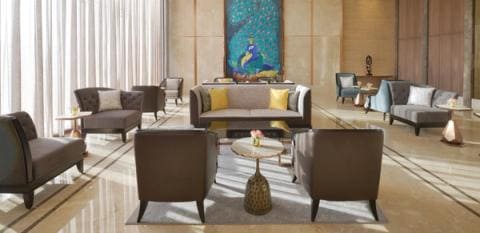
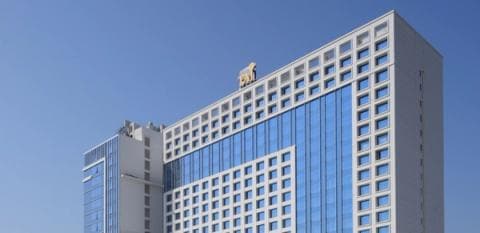
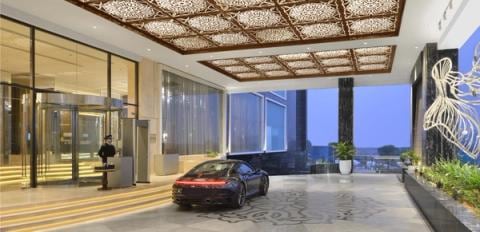
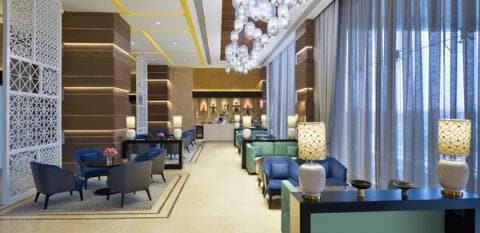
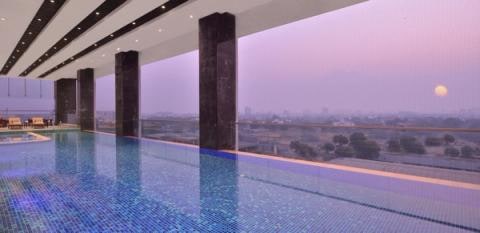
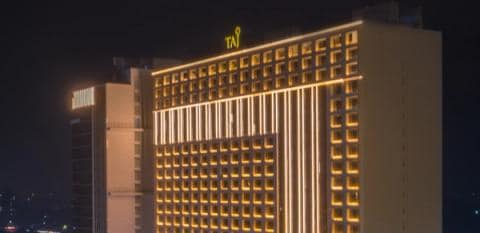
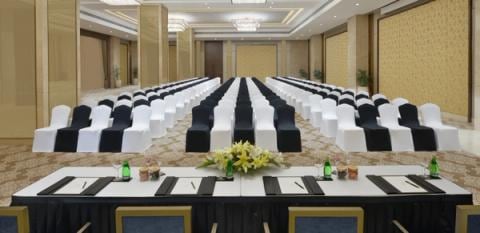








Taj Skyline, Ahmedabad
Taj Skyline, Ahmedabad
20 Dec 2025
1 Room
Special Code

Attractions & Placesto Visit in Ahmedabad
Title :
Kankaria Lake
Description :
The 15th century man-made lake is the city’s largest and has a vibrant lakefront which hosts family-friendly attractions and activities, including a zoo, speed boat riding and toy train rides. It sparkles even more during the annual week-long Kankaria Carnival in December, when you can enjoy cultural programs, performances by renowned artists, musical evenings, rock shows, fireworks and more revelry.
Kankaria Lake
Title :
Gujarat Science City
Description :
Built to communicate scientific knowledge in an engaging and interactive manner, this massive complex offers 3D shows, rides and exhibits. From cutting-edge scientific displays and a Robotics Gallery to an Energy Park exhibiting five basic elements (pancha bhuta) as propounded in ancient Indian philosophy, there’s much to see and do here for curious minds of all ages.
Gujarat Science City
Title :
Thol Lake Sanctuary
Description :
A haven for migratory birds, the sanctuary is spread over an area of 7 square kilometres, including Thol lake, marshlands and scrub forests. Home to several endangered bird species such as the Sarus crane, flamingos and pelicans, it hosts flocks of migratory birds - especially waterbirds - between November and February, and a large population of blackbuck (Indian antelope) in summers. The destination is an excellent weekend retreat for nature lovers and photographers.
Thol Lake Sanctuary
Title :
Sabarmati Ashram
Description :
Formerly known as Satyagraha Ashram, the residence of Mahatma Gandhi has witnessed crucial events in India’s freedom struggle, including the start of the Dandi March. Within the 36-acre grounds, visit the Hridaya (Heart) Kunj to see Gandhiji’s personal writing desk, letters alongside a yarn spun by him and the Gandhi Sangrahalay (Museum) which has a library, two photo-galleries and an auditorium.
Sabarmati Ashram
Title :
Hussain-Doshi Gufa
Description :
Also known as Amdavad ni Gufa, this distinctive gallery is set underground with only the domed roof shells - finished in dazzling china mosaic with a black serpentine imagery snaking across the surfaces - protruding above the ground level. From the exterior, the gufa (cave) looks like an eccentric work of art, which is fitting, as the museum - designed by Pritzker Prize-winning architect Balkrishna Doshi - exhibits works of his friend and collaborator, artist Maqbool Fida Hussain. Enter the space through a staircase, which is partly hidden, through a circular door to experience a unique marriage of art and architecture.
Hussain-Doshi Gufa
Title :
Calico Museum of Textiles
Description :
Home to one of the world’s finest collections of antique and modern Indian textiles, this museum displays the full glory of Ahmedabad and India’s textile legacy. Marvel at Kashmiri shawls that took three years to make, and double-ikat fabrics whose 100,000 threads were individually dyed before weaving.
Calico Museum of Textiles
Title :
Jama Masjid
Description :
Built in 1423, one of India’s most beautiful mosques displays an architectural blend of Hindu and Jain influences within a massive tranquil courtyard. Constructed as part of a larger design of the city, it lies south of the processional axis that runs from the Maidan-i Shah with three arches called Teen Darwaza in the old city. The prayer hall’s 260 columns support 15 principal domes at different elevations.
Jama Masjid
Title :
Sarkhej Roza
Description :
A treat for antiquarians and photographers, this 72-acre ancient necropolis in sandstone and marble reflects the architectural ambitions of the Gujarat sultans. Eminent Swiss-French architect Le Corbusier is said to have compared it to the Acropolis of Athens. The complex includes a mosque, mausoleums, palace, tank and pavilions that blend Islamic-style domes with Hindu craftsmanship and motifs. Visitors are expected to remove their footwear and cover their head with a piece of cloth before entering this sacred site.
Sarkhej Roza
Title :
Auto World Vintage Car Museum
Description :
Nestled in a 2,200-acre estate in Dastaan, one of India’s biggest personal collections of over 200 vintage cars, bikes and buggies is the work of collector Pranlal Bhogilal who founded the Vintage and Classic Car Club of India. Some of it’s highlights include a Rolls-Royce Phantom I, 1926 painted with the colors of India’s flag; a Rolls-Royce Silver Ghost, 1923 and a Hispano Suiza H6C, 1927 custom-built for erstwhile rulers of the Alwar state, fitted with special cabinets to hold rifles and shotguns for their hunting expeditions.
Auto World Vintage Car Museum
Title :
Lokmanya Tilak Garden (Victoria Garden)
Description :
Known for manicured lawns, vibrant flower beds and charming pathways, the city’s green lungs provide the perfect setting for leisurely walks, family picnics and bird watching. If you’re in the city on a weekend, don’t forget to visit the six-decade old (Ravivari) Sunday Market held here, teeming with second-hand curios and rare finds.
Lokmanya Tilak Garden (Victoria Garden)
Title :
Bhadra Fort
Description :
A historical gem built in 1411 by Sultan Ahmad Shah, the fort is a stunning representation of Indo-Islamic architecture, housing beautiful gardens, intricate carvings and the revered Bhadra Kali Temple. Teen Darwaza, an imposing gateway on the eastern side, leads to a bustling market. Climb up to the roof of the fort for a panoramic view of the old city.
Bhadra Fort
Title :
Hutheesing Temple
Description :
Built in 1848 by a wealthy merchant, this marble masterpiece is dedicated to Lord Dharmanath, the 15th Jain Tirthankara. Ornate pillars, exquisitely decorated columns, carved spires alongwith elegant carvings of dancers, musicians and deities in white marble make it one of the city’s most stunning temples.
Hutheesing Temple
Title :
Adalaj Vav
Description :
The flamboyant 15th-century vav (stepwell) will leave you awestruck with its Indo-Islamic architecture and intricately carved pillars supporting five storeys. An opening in the ceiling allows light and air to enter the octagonal well, but direct sunlight doesn’t touch the steps, except at noon. Some of the mythological carvings include Ami Khumbor (a pot containing the water of life) and Kalp Vriksha (tree of life) carved out of a single slab of stone. There is a belief that the small frieze of Navagraha (nine-planets) towards the edge of the well protects the monument from bad omens.
Adalaj Vav
Title :
Kankaria Lake
Description :
The 15th century man-made lake is the city’s largest and has a vibrant lakefront which hosts family-friendly attractions and activities, including a zoo, speed boat riding and toy train rides. It sparkles even more during the annual week-long Kankaria Carnival in December, when you can enjoy cultural programs, performances by renowned artists, musical evenings, rock shows, fireworks and more revelry.
Kankaria Lake
Title :
Gujarat Science City
Description :
Built to communicate scientific knowledge in an engaging and interactive manner, this massive complex offers 3D shows, rides and exhibits. From cutting-edge scientific displays and a Robotics Gallery to an Energy Park exhibiting five basic elements (pancha bhuta) as propounded in ancient Indian philosophy, there’s much to see and do here for curious minds of all ages.
Gujarat Science City
Title :
Thol Lake Sanctuary
Description :
A haven for migratory birds, the sanctuary is spread over an area of 7 square kilometres, including Thol lake, marshlands and scrub forests. Home to several endangered bird species such as the Sarus crane, flamingos and pelicans, it hosts flocks of migratory birds - especially waterbirds - between November and February, and a large population of blackbuck (Indian antelope) in summers. The destination is an excellent weekend retreat for nature lovers and photographers.
Thol Lake Sanctuary
Title :
Sabarmati Ashram
Description :
Formerly known as Satyagraha Ashram, the residence of Mahatma Gandhi has witnessed crucial events in India’s freedom struggle, including the start of the Dandi March. Within the 36-acre grounds, visit the Hridaya (Heart) Kunj to see Gandhiji’s personal writing desk, letters alongside a yarn spun by him and the Gandhi Sangrahalay (Museum) which has a library, two photo-galleries and an auditorium.
Sabarmati Ashram
Title :
Hussain-Doshi Gufa
Description :
Also known as Amdavad ni Gufa, this distinctive gallery is set underground with only the domed roof shells - finished in dazzling china mosaic with a black serpentine imagery snaking across the surfaces - protruding above the ground level. From the exterior, the gufa (cave) looks like an eccentric work of art, which is fitting, as the museum - designed by Pritzker Prize-winning architect Balkrishna Doshi - exhibits works of his friend and collaborator, artist Maqbool Fida Hussain. Enter the space through a staircase, which is partly hidden, through a circular door to experience a unique marriage of art and architecture.
Hussain-Doshi Gufa
Title :
Calico Museum of Textiles
Description :
Home to one of the world’s finest collections of antique and modern Indian textiles, this museum displays the full glory of Ahmedabad and India’s textile legacy. Marvel at Kashmiri shawls that took three years to make, and double-ikat fabrics whose 100,000 threads were individually dyed before weaving.
Calico Museum of Textiles
Title :
Jama Masjid
Description :
Built in 1423, one of India’s most beautiful mosques displays an architectural blend of Hindu and Jain influences within a massive tranquil courtyard. Constructed as part of a larger design of the city, it lies south of the processional axis that runs from the Maidan-i Shah with three arches called Teen Darwaza in the old city. The prayer hall’s 260 columns support 15 principal domes at different elevations.
Jama Masjid
Title :
Sarkhej Roza
Description :
A treat for antiquarians and photographers, this 72-acre ancient necropolis in sandstone and marble reflects the architectural ambitions of the Gujarat sultans. Eminent Swiss-French architect Le Corbusier is said to have compared it to the Acropolis of Athens. The complex includes a mosque, mausoleums, palace, tank and pavilions that blend Islamic-style domes with Hindu craftsmanship and motifs. Visitors are expected to remove their footwear and cover their head with a piece of cloth before entering this sacred site.
Sarkhej Roza
Title :
Auto World Vintage Car Museum
Description :
Nestled in a 2,200-acre estate in Dastaan, one of India’s biggest personal collections of over 200 vintage cars, bikes and buggies is the work of collector Pranlal Bhogilal who founded the Vintage and Classic Car Club of India. Some of it’s highlights include a Rolls-Royce Phantom I, 1926 painted with the colors of India’s flag; a Rolls-Royce Silver Ghost, 1923 and a Hispano Suiza H6C, 1927 custom-built for erstwhile rulers of the Alwar state, fitted with special cabinets to hold rifles and shotguns for their hunting expeditions.
Auto World Vintage Car Museum
Title :
Lokmanya Tilak Garden (Victoria Garden)
Description :
Known for manicured lawns, vibrant flower beds and charming pathways, the city’s green lungs provide the perfect setting for leisurely walks, family picnics and bird watching. If you’re in the city on a weekend, don’t forget to visit the six-decade old (Ravivari) Sunday Market held here, teeming with second-hand curios and rare finds.
Lokmanya Tilak Garden (Victoria Garden)
Title :
Bhadra Fort
Description :
A historical gem built in 1411 by Sultan Ahmad Shah, the fort is a stunning representation of Indo-Islamic architecture, housing beautiful gardens, intricate carvings and the revered Bhadra Kali Temple. Teen Darwaza, an imposing gateway on the eastern side, leads to a bustling market. Climb up to the roof of the fort for a panoramic view of the old city.
Bhadra Fort
Title :
Hutheesing Temple
Description :
Built in 1848 by a wealthy merchant, this marble masterpiece is dedicated to Lord Dharmanath, the 15th Jain Tirthankara. Ornate pillars, exquisitely decorated columns, carved spires alongwith elegant carvings of dancers, musicians and deities in white marble make it one of the city’s most stunning temples.
Hutheesing Temple
Title :
Adalaj Vav
Description :
The flamboyant 15th-century vav (stepwell) will leave you awestruck with its Indo-Islamic architecture and intricately carved pillars supporting five storeys. An opening in the ceiling allows light and air to enter the octagonal well, but direct sunlight doesn’t touch the steps, except at noon. Some of the mythological carvings include Ami Khumbor (a pot containing the water of life) and Kalp Vriksha (tree of life) carved out of a single slab of stone. There is a belief that the small frieze of Navagraha (nine-planets) towards the edge of the well protects the monument from bad omens.
Adalaj Vav
Title :
Kankaria Lake
Description :
The 15th century man-made lake is the city’s largest and has a vibrant lakefront which hosts family-friendly attractions and activities, including a zoo, speed boat riding and toy train rides. It sparkles even more during the annual week-long Kankaria Carnival in December, when you can enjoy cultural programs, performances by renowned artists, musical evenings, rock shows, fireworks and more revelry.
Kankaria Lake
Title :
Gujarat Science City
Description :
Built to communicate scientific knowledge in an engaging and interactive manner, this massive complex offers 3D shows, rides and exhibits. From cutting-edge scientific displays and a Robotics Gallery to an Energy Park exhibiting five basic elements (pancha bhuta) as propounded in ancient Indian philosophy, there’s much to see and do here for curious minds of all ages.
Gujarat Science City
Title :
Thol Lake Sanctuary
Description :
A haven for migratory birds, the sanctuary is spread over an area of 7 square kilometres, including Thol lake, marshlands and scrub forests. Home to several endangered bird species such as the Sarus crane, flamingos and pelicans, it hosts flocks of migratory birds - especially waterbirds - between November and February, and a large population of blackbuck (Indian antelope) in summers. The destination is an excellent weekend retreat for nature lovers and photographers.
Thol Lake Sanctuary
Itineraries
Itineraries
TRAVEL STORIES
TRAVEL STORIES
Unveiling the Charms of Ahmedabad
Bustling Bazaars of India
GIFT HAMPERS
Taj hampers convey warm sentiments with luxury accessories, culinary treats and artisanal sweets (mithai). Brighten celebrations as you choose from cu...BREAKFAST INCLUSIVE RATE
Wake up to a symphony of flavours with our delectable breakfast spread and enjoy seamless internet connectivity and flexible cancellation for that add...BEST AVAILABLE RATE
Offering an unparalleled blend of plush comfort and elegance, our exclusive room-only rate comes with the added convenience of seamless internet conne...HOTELS IN AHMEDABAD
Unwind in the luxurious and well appointed rooms. Our hotels in Ahmedabad offer easy access to key business districts, historical sights, important ci...NEUPASS
Earn and redeem NeuCoins for exclusive member rates, with your Neupass membership. Indulge in memorable getaways, gourmet delights, spa treatments and...EPICURE
Epicure lifestyle memberships are made for sheer indulgence. Crafted for the creation of special moments, benefits encompass plush rooms & suites, fin...TIMELESS WEDDINGS
Experience the magic of a Taj wedding with our expert planners crafting flawless events, creating timeless memories for generations.J WELLNESS CIRCLE
Embark on a wellness journey infused with ancient Indian healing energies and experiences, revitalizing your mind, body, and spirit.EXCLUSIVE OFFERS
Enjoy exclusive deals on stays, delectable dining experiences, and rejuvenating spa treatments. Elevate your moments with us. Book now to savor unpara...TAJ EXPERIENCE GIFT CARDS
Gift the luxury of a moment that will become a cherished memory. An exclusive experience, carefully selected, crafted and refined by time.GIFT HAMPERS
Taj hampers convey warm sentiments with luxury accessories, culinary treats and artisanal sweets (mithai). Brighten celebrations as you choose from cu...BREAKFAST INCLUSIVE RATE
Wake up to a symphony of flavours with our delectable breakfast spread and enjoy seamless internet connectivity and flexible cancellation for that add...BEST AVAILABLE RATE
Offering an unparalleled blend of plush comfort and elegance, our exclusive room-only rate comes with the added convenience of seamless internet conne...HOTELS IN AHMEDABAD
Unwind in the luxurious and well appointed rooms. Our hotels in Ahmedabad offer easy access to key business districts, historical sights, important ci...NEUPASS
Earn and redeem NeuCoins for exclusive member rates, with your Neupass membership. Indulge in memorable getaways, gourmet delights, spa treatments and...EPICURE
Epicure lifestyle memberships are made for sheer indulgence. Crafted for the creation of special moments, benefits encompass plush rooms & suites, fin...TIMELESS WEDDINGS
Experience the magic of a Taj wedding with our expert planners crafting flawless events, creating timeless memories for generations.J WELLNESS CIRCLE
Embark on a wellness journey infused with ancient Indian healing energies and experiences, revitalizing your mind, body, and spirit.EXCLUSIVE OFFERS
Enjoy exclusive deals on stays, delectable dining experiences, and rejuvenating spa treatments. Elevate your moments with us. Book now to savor unpara...TAJ EXPERIENCE GIFT CARDS
Gift the luxury of a moment that will become a cherished memory. An exclusive experience, carefully selected, crafted and refined by time.GIFT HAMPERS
Taj hampers convey warm sentiments with luxury accessories, culinary treats and artisanal sweets (mithai). Brighten celebrations as you choose from cu...